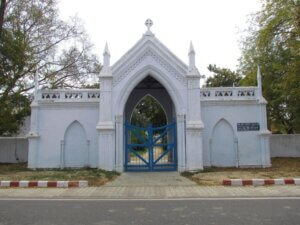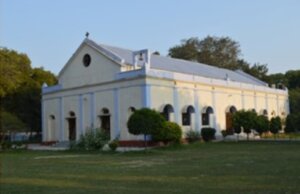This is the fifth, and final, post in a series by Prof Peter Stanley, the distinguished Australian military historian, who recently visited several historical sites in India gathering material for his forthcoming book (John Company’s Armies: the Military Forces of British India 1824-57).
This post covers places Prof Stanley visited in Agra. Previously published posts covered his visits to the Landour, Roorkee and Dehradun area (18/1/24); to Lucknow (12/2/24); to Kolkata, Barrackpore and Serampore (25/2/24), and to Gwalior, Jhansi and Maharajpoor (13/4/24).
St George’s Church
‘I must be one of the very few people to visit Agra but not see the Taj Mahal (though I had visited it twice before).
Instead, I was eager to visit the cantonment, starting with St George’s Church.

(Photo: E Hozefa, 2017)
Now a cathedral, St George’s had been built in 1828 by Lieutenant John Boileau. The following year he and his brother Henry (also a Bengal engineer) married two sisters in St George’s, and on St George’s day. A fine example of Company architecture, the well-preserved St George’s contains many memorials, including several dating from the 1840s and ‘50s, and a memorial commemorating 41 Territorials of the East Surrey Regiment, who died while it was stationed in Agra during the Great War.
Agra Cantonment Cemetery
I also wanted to see Agra’s large cantonment cemetery – the subject of one of BACSA’s most comprehensive cemetery listings.
This proved to be not as easy as I had hoped. In previous visits to India, I had generally been able to visit cantonment cemeteries freely. While prudence had always been advisable – keeping cameras discreet, for example, was wise – and while some cantonments had become somewhat harder to enter, they had mostly been accessible. Now, however, the Indian Army has adopted a much more restricted approach, exemplified by the signs I had seen in Delhi, Lucknow, Barrackpore and Kolkata: ‘SUSPECT ALL, RESPECT ALL, INSPECT ALL’.

The notice on the right reads: ‘Agra Joint Cemetery Committee, Agra Cantonment (Gora) Cemetery, Grand Parade Road, Agra’
At Agra, it proved impossible at first to visit the cantonment cemetery, now within the lines of a Parachute Regiment Special Forces battalion, which forbade entry to all but authorised persons: and a tourist in a tuk-tuk was the definition of unauthorised. It took the intercession of the Uttar Pradesh Tourist Police and an hour of explaining, negotiating and waiting at two gates before a jawan waved us through. Less experienced visitors without a business card identifying them as a Research Professor at the Australian Defence Force Academy might have come a long way only to be refused entry. This is a potentially significant caution for BACSA members wishing to visit cantonment cemeteries.
However, thanks to a veteran of the Indian Army, I did get in, and found that the experience was worthwhile. I happened to visit on All Souls’ Day, and the cemetery was busy with both Indian Christians sprucing up loved ones’ graves (like Nishat Ganj at Lucknow, the Agra cantonment cemetery is still used by the local community) and of workers clearing vegetation and re-laying paths.
I spent a happy hour photographing many graves, mainly those relating to the Bengal Army in the decades 1824-57, a focus of John Company’s Armies. Even the potential disaster of dropping my phone was soon overcome by asking my tuk-tuk driver to call my number until the phone was found – a reminder that obtaining an Indian sim card was a precaution which paid dividends repeatedly throughout the trip – and earned him a Rs1000 tip.
Agra Cantonment
The next day, I engaged another local guide, an Agra lawyer who offers tours of ‘Colonial Agra’, taking in parts of the cantonment which casual visitors may not know of, or be able to gain access to. My guide welcomed me into his own bungalow (probably built in the 1830s), and took me to St George’s, the Telegraph Office (dating from the 1850s), the Agra Club, the Post Office (a Saracenic-Byzantine fantasy built in 1913), the Queen Mary Imperial Library (sadly, now derelict) and the Havelock Memorial Church.
This modest building was constructed in the 1870s, replacing an earlier non-conformist chapel built in 1828 at the instigation of Henry Havelock, one of the evangelical British officers who sought to improve the spiritual and moral wellbeing of his men (in his case HM 13th Regiment). It too held numerous memorial plaques.

(Photo: colonialwalkagra.com)

(Photo: colonialwalkagra.com)
The Agra cantonment tour gave me insights into one of the finest surviving examples of an Indian cantonment – indeed, I had included a map of it in my ‘Terriers’ in India, because it was so representative.
As a whole, my three-week visit to India, seeking out cantonments, cemeteries, churches, and battlefields, achieved all of the objectives I had set, with the exception of minor disappointments such as not being able to visit Mussoorie cemetery or Flagstaff House, Barrackpore. It showed that visiting India was worthwhile for those seeking to gain an understanding of British India’s history and its surviving heritage.’
Peter Stanley
Ed. notes:
•Compiled by Robin Volker in 2001, ‘Agra Cantonment Cemetery’, a record of over 5,000 burials from 1806-1990s, including all existing Memorial Inscriptions and plot diagrams indicating the shape and location of the tombs, may be purchased through the Shop facility on the BACSA website.
•Camel’s Back Cemetery, Mussoorie: After visiting Landour in Oct/Nov 2023, Prof Stanley had also attempted to visit ‘the larger and well maintained main Mussoorie cemetery at about 9 a.m., but it was padlocked, and may only be open later in the morning’.
Rachel Magowan
